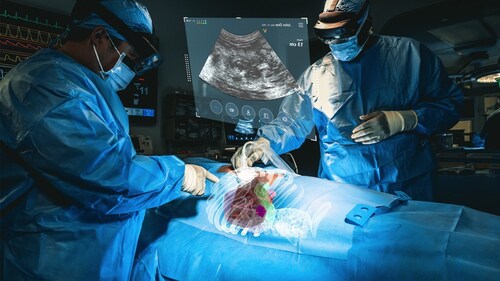Discover how XR is reshaping healthcare and defense, transforming training, surgery, and mission readiness from lab prototypes to life-critical applications.
If You Lead Innovation, This is Your Signal
Once surgeons and soldiers start building XR into their standard workflows, it’s clear the technology has moved beyond promise to performance. In just three years, XR has moved from proof-of-concept to critical infrastructure in both healthcare and defense, and the latest breakthroughs reveal how deeply it’s embedding into real-world operations.
XR in Healthcare: Operating in Another Dimension
In 2022, we reported that MediView XR raised $9.9M to advance AR-guided telehealth and surgical visualisation: “X-ray vision” overlays that align 3D anatomy to the patient in real time. That early cash signalled clinical curiosity and a credible roadmap, not just a flashy demo.
Fast-forward to October 2025: GE HealthCare leads a $24M Series A into MediView, alongside Cleveland Clinic and Mayo Clinic. The company’s FDA-cleared platform fuses CT and ultrasound into a spatial display, letting clinicians see 3D anatomy through the skin and navigate minimally invasive procedures with more confidence. That’s a leap from early-stage innovation to large-scale clinical deployment, backed by some of the most influential names in healthcare.
MediView CEO Mina Fahim says:
“[The company’s mission is to] “simplify, democratize, and inform medical procedures”
A goal that reflects how enterprise-grade AR is moving from complexity to clarity in high-stakes environments.
Why does this matter? Hospitals don’t invest for novelty. They invest for safety, repeatability, and workflow efficiency. AR isn’t just a nice-to-have – it can reduce cognitive load, strengthen team coordination, and ultimately help medical professionals save lives.

(MediView XR90 Augmented Reality-Based Visualization and Navigation Platform. Image from PR Newswire.com)
From Pilot to Platform, Varjo’s XR-4 Takes Flight
AR defense tech vendor, Varjo, has announced a refreshed XR-4 series built for air, land, and sea training; a headset line first launched in 2023 and now tuned for broad deployment. The update improves comfort, adds night modes and SteamVR compatibility, and sharpens AI-assisted passthrough and gaze prediction – the kind of fidelity and reliability defense buyers insist on. Patrick Wyatt, Varjo’s CPO, says the team:
“…worked closely with our simulation and training customers to understand the needs of broad-scale deployment”
A reminder that defense-grade XR is shaped in the field, not the lab.
The XR-4 delivers 51 PPD visuals, a 120° x 105° field of view, and 20+ megapixel stereo passthrough. But the real milestone is program-grade support through 2030, ensuring stability for large-scale defense deployments. In procurement, long-term reliability often matters as much as visual fidelity.
If militaries are replacing portions of live training and classroom drills with photoreal MR, it’s because the simulation gap is narrowing, not just for visuals, but for procedural memory and team coordination. That pattern will likely repeat anywhere mistakes are expensive: energy, aviation MRO, and critical infrastructure.
Spatial Collaboration and the Future of XR
Picture a surgical team guided by AR overlays mapped to the patient, remote specialists joining in real time, and a unit across the country training in a mixed reality twin built from live terrain data. That’s spatial collaboration built seamlessly into the way people already work, not added as an afterthought.
When operating rooms and training ranges choose XR, they’re not gambling on the metaverse; they’re buying clarity. The question for the rest of us isn’t whether immersive tech will show up in our stack – it’s whether we’ll be ready to scale it with the same discipline that these critical sectors are beginning to.
Related Stories
Quelle:
https://www.xrtoday.com/event-news/how-xr-is-powering-life-and-death-industries/






